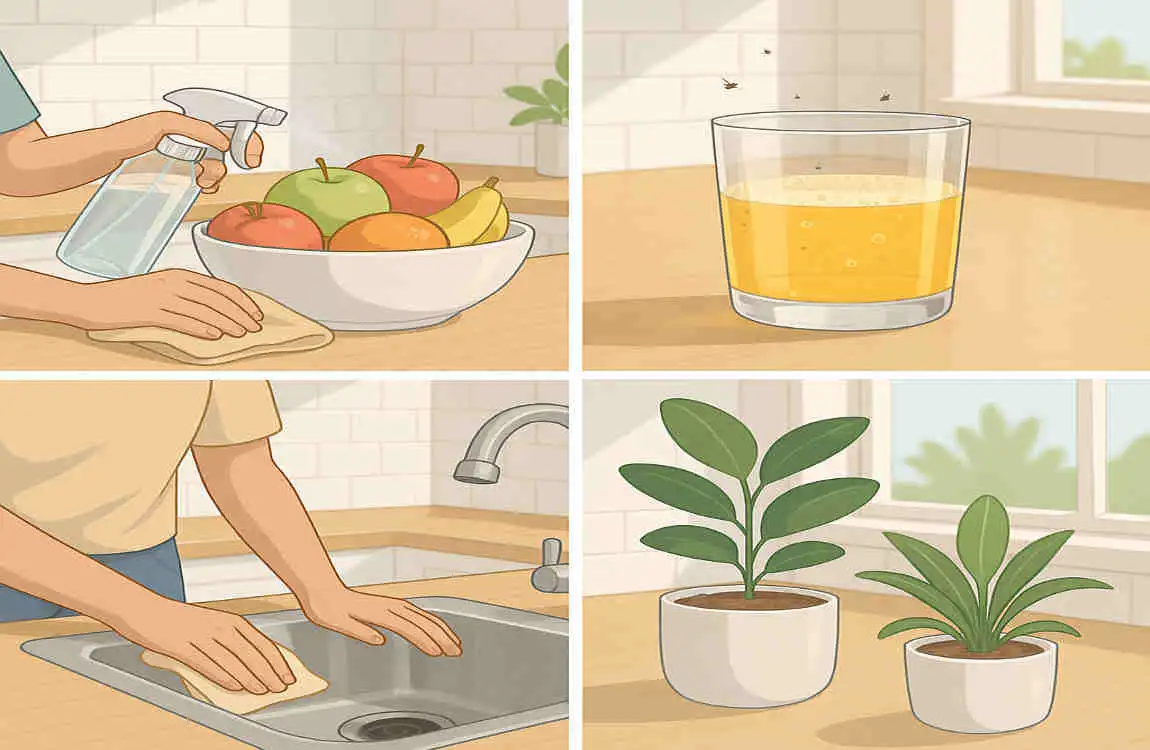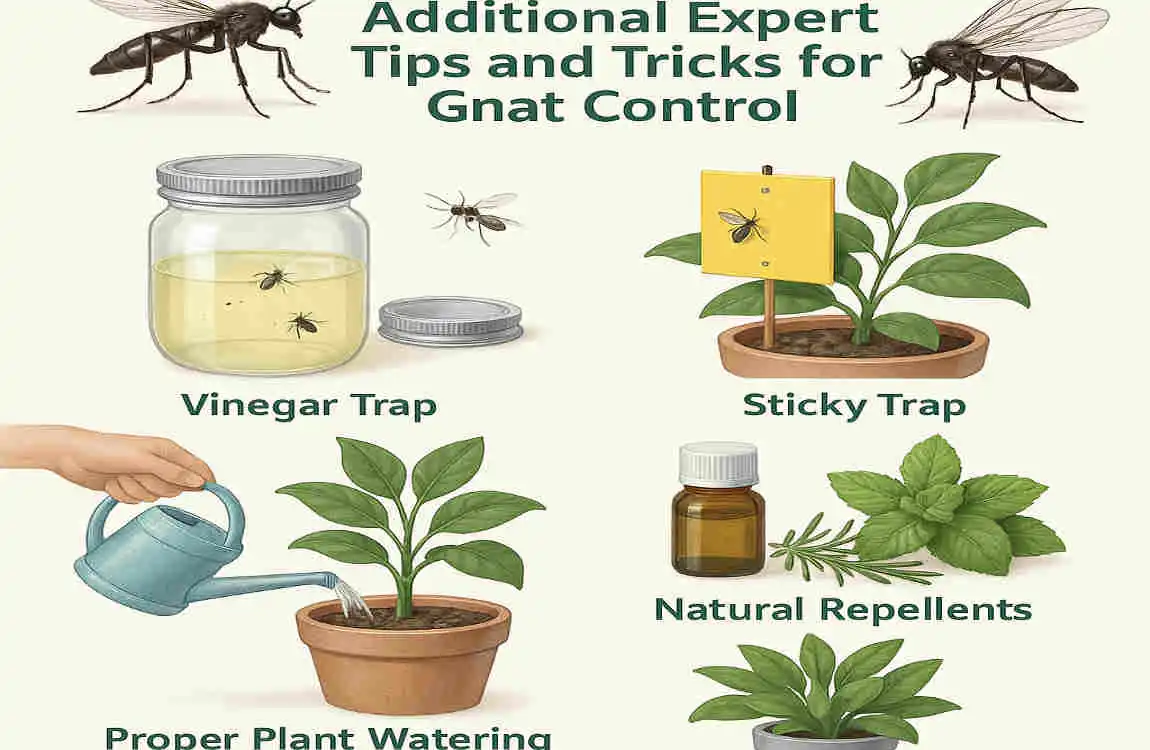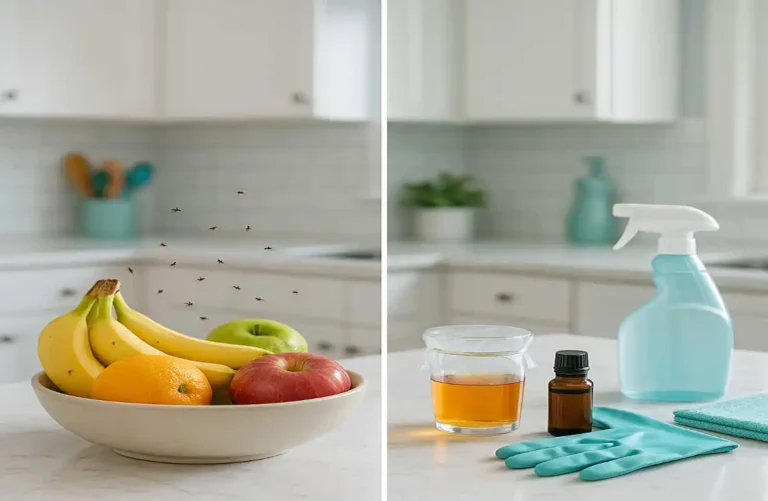Gnats can be a real nuisance in our homes. These tiny flying insects appear out of nowhere and multiply rapidly. But did you know that gnats can also impact our hygiene? They’re attracted to food and moisture, which can lead to contamination and unsanitary conditions. That’s why it’s crucial to have practical house-cleaning tips to kill gnats quickly and prevent infestations.
What Are Gnats? Understanding the Pest

Definition and Description of Gnats
Gnats are small, flying insects that belong to various families. In homes, we commonly encounter three types: fungus gnats, fruit flies, and drain flies. Fungus gnats are attracted to moist soil and decaying organic matter, while fruit flies love fermenting fruits and vegetables. Drain flies, as their name suggests, thrive in damp areas like sinks and drains.
Life Cycle and Breeding Habits
Gnats have a short life cycle, which allows them to multiply quickly indoors. Female gnats lay eggs in moist areas, and these eggs hatch into larvae within days. The larvae then develop into pupae and eventually emerge as adult gnats. This rapid reproduction makes it essential to address gnat infestations promptly.
Attraction to Certain Areas
Gnats are drawn to specific areas of the house because they prefer moisture, food, and breeding sites. They’re commonly found in kitchens near fruits and vegetables, around indoor plants, and in bathrooms near sinks and drains. Understanding these attractions can help us target our cleaning efforts more effectively.
Health and Hygiene Concerns
While gnats themselves don’t pose significant health risks, they can contaminate food and surfaces. Their presence may indicate unsanitary conditions or poor food storage practices. By keeping gnats under control, we can maintain a cleaner, healthier living environment.
Signs of a Gnat Infestation in Your Home
Common Indicators
If you suspect a gnat infestation, look for these telltale signs:
- Swarms of small flying insects, especially near food, plants, or moisture sources
- Tiny black or brown specks on surfaces, which may be gnat larvae or pupae
- A musty or sour smell, particularly around drains or garbage areas
Differentiating Gnats from Other Insects
It’s essential to distinguish gnats from other flying pests, such as fruit flies and mosquitoes. Gnats are generally smaller, with long, slender bodies and long legs. They tend to fly erratically and are often seen hovering around plants or moist areas.
Areas to Inspect
When searching for gnats, focus on these typical hotspots:
- Kitchen: Check around fruits, vegetables, and garbage cans
- Bathroom: Inspect sinks, drains, and areas with standing water
- Indoor plants: Examine soil and leaves for signs of fungus gnats
- Drains: Look for drain flies in sink and shower drains
Importance of Early Detection
Catching a gnat infestation early is key to effective control. By identifying the problem promptly, you can take action before the population grows out of control. Regular inspections and maintaining good hygiene practices can help you stay ahead of gnats.
Proven House Cleaning Tips to Kill Gnats Fast
Clean Up Food and Moisture Sources
Remove Overripe Fruits and Clean Spills Promptly
Gnats love fermenting fruits and sugary spills. To eliminate their food sources, promptly remove any overripe or rotting produce from your kitchen. Clean up spills and crumbs as soon as they happen, especially on countertops and floors.
Store Food in Sealed Containers
Keep pantry items like grains, flour, and sugar in airtight containers to prevent gnat infestations. This not only discourages gnats but also helps maintain food freshness and quality.
Keep Kitchen Counters and Sinks Dry
Gnats thrive in moist environments, so it’s crucial to keep your kitchen surfaces dry. Wipe down counters and sinks regularly, and fix any leaks or drips that could create standing water.
Manage Indoor Plants Smartly
Avoid Overwatering Indoor Plants
Fungus gnats are attracted to moist soil, so be careful not to overwater your houseplants. Allow the top inch of soil to dry out between waterings, and use well-draining potting mixes to prevent waterlogging.
Use Sand or Gravel on Top of Soil
Applying a thin layer of sand or gravel on top of the soil can help prevent fungus gnats from laying eggs. This barrier makes it difficult for adult gnats to reach the soil and deposit their eggs.
Inspect Plants Regularly
Keep an eye on your indoor plants for signs of fungus gnats. If you notice tiny black flies hovering around your plants or larvae in the soil, take action promptly to prevent the infestation from spreading.
Drain Cleaning Tips
How to Clean Drains Where Gnats Breed
Drain flies can be a persistent problem, but you can tackle them with these simple cleaning methods:
- Pour boiling water down the drain to kill adult flies and larvae
- Use a mixture of vinegar and baking soda to break down organic matter and eliminate odors
- For stubborn infestations, consider using a drain cleaner specifically designed to target drain flies
Using Drain Cleaners Safely and Effectively
When using chemical drain cleaners, always follow the manufacturer’s instructions carefully. Wear protective gloves and eyewear, and ensure proper ventilation in the area. Avoid using drain cleaners in combination with other chemicals, as this can create hazardous fumes.
Use Natural and Homemade Gnat Traps
Recipes for Vinegar Traps and Sugar Water Traps
You can create simple, effective gnat traps using everyday household items:
- Vinegar trap: Fill a small bowl or jar with apple cider vinegar and cover it with plastic wrap. Poke small holes in the plastic to let gnats in but not out.
- Sugar water trap: Mix equal parts sugar and water in a shallow dish. Add a few drops of dish soap to break the surface tension, causing gnats to drown when they land on the liquid.
Placement Tips for Best Results
Place your homemade traps near areas where gnats are most active, such as kitchen counters, sinks, and around indoor plants. Replace the traps every few days or when they become full of dead gnats.
Integration with House Cleaning Routines
Incorporate these traps into your regular cleaning schedule to maintain their effectiveness. Empty and refill the traps as needed, and clean the surrounding areas to remove any food or moisture sources that may attract gnats.
Effective Use of Insecticides and Sprays
Recommendations for Safe Insecticides
If natural methods aren’t enough to control your gnat infestation, consider using indoor-use insecticides. Look for products containing pyrethrin or pyrethroids, which are effective against gnats and relatively safe for humans and pets when used as directed.
When to Use Sprays vs Traps
Sprays are best used for targeted treatments in areas with high gnat activity, such as around plants or in kitchens and bathrooms. Traps, on the other hand, are more suitable for monitoring and capturing gnats over time. Use both methods in combination for comprehensive control.
Precautions and Ventilation Tips
When using insecticides indoors, always follow the label instructions carefully. Wear protective clothing and ensure proper ventilation in the treated area. Keep children and pets away from treated surfaces until the product has dried completely.
Preventing Future Gnat Infestations Through House Cleaning
Develop a Regular Cleaning Schedule
Consistency is key to preventing gnat infestations. Create a cleaning schedule that focuses on gnat hotspots, such as kitchens, bathrooms, and areas with indoor plants. By maintaining a clean environment, you can disrupt the gnats’ breeding cycle and prevent future problems.
Best Practices for Garbage Disposal and Recycling
Proper garbage and recycling management is crucial for gnat control. Keep trash cans clean and empty them regularly, especially if they contain food waste. Rinse out recyclables before placing them in the bin, and store the bin in a cool, dry area to minimize moisture buildup.
Proper Maintenance of Sinks, Drains, and Compost Bins
Regularly clean and maintain your sinks, drains, and compost bins to prevent gnat breeding. Use drain cleaners or boiling water to keep drains free of organic matter, and turn your compost regularly to aerate it and speed up decomposition.
Air Circulation and Reducing Humidity
Good air circulation and low humidity levels can help discourage gnats from taking up residence in your home. Use fans or open windows to improve airflow, and consider using a dehumidifier in damp areas like basements or bathrooms.
Using Dehumidifiers if Necessary
If your home tends to be humid, a dehumidifier can be a valuable tool in your gnat prevention arsenal. These devices remove excess moisture from the air, making your home less inviting to gnats and other moisture-loving pests.
Additional Expert Tips and Tricks for Gnat Control

Professional Pest Control Options
If your gnat infestation persists despite your best efforts, it may be time to call in the professionals. Pest control experts have access to specialized products and techniques that can help eliminate gnats and prevent future problems.
Using UV Light Traps and Other Tech Solutions
UV light traps can be an effective way to capture and kill gnats. These devices use ultraviolet light to attract gnats, which then become stuck on a sticky surface or electrocuted. Consider placing UV light traps in areas where gnats are most active.
Maintaining Houseplants and Storage for Long-Term Prevention
To prevent future gnat infestations, take a proactive approach to maintaining your houseplants and storage areas. Choose plants that are less susceptible to fungus gnats, and use well-draining soil and pots. Keep storage areas clean and dry, and regularly inspect them for signs of gnats or other pests.
Why Consistency in House Cleaning is Key to Gnat Control
Disrupting Gnat Breeding Cycles
Regular cleaning is essential for disrupting the gnat breeding cycle. By removing food and moisture sources, cleaning up spills and debris, and maintaining a clean environment, you can prevent gnats from laying eggs and multiplying.
Maintaining Motivation and Using Checklists
Staying motivated to maintain your cleaning routine can be challenging, but it’s crucial for long-term gnat control. Create a checklist of tasks to help you stay on track, and reward yourself for your efforts. Remember, a clean home is a gnat-free home!
Benefits of a Gnat-Free Home
A home free of gnats offers numerous benefits. Not only will you enjoy a cleaner, more hygienic living space, but you’ll also reduce the risk of food contamination and unsanitary conditions. Plus, a gnat-free home is simply more pleasant to live in!

